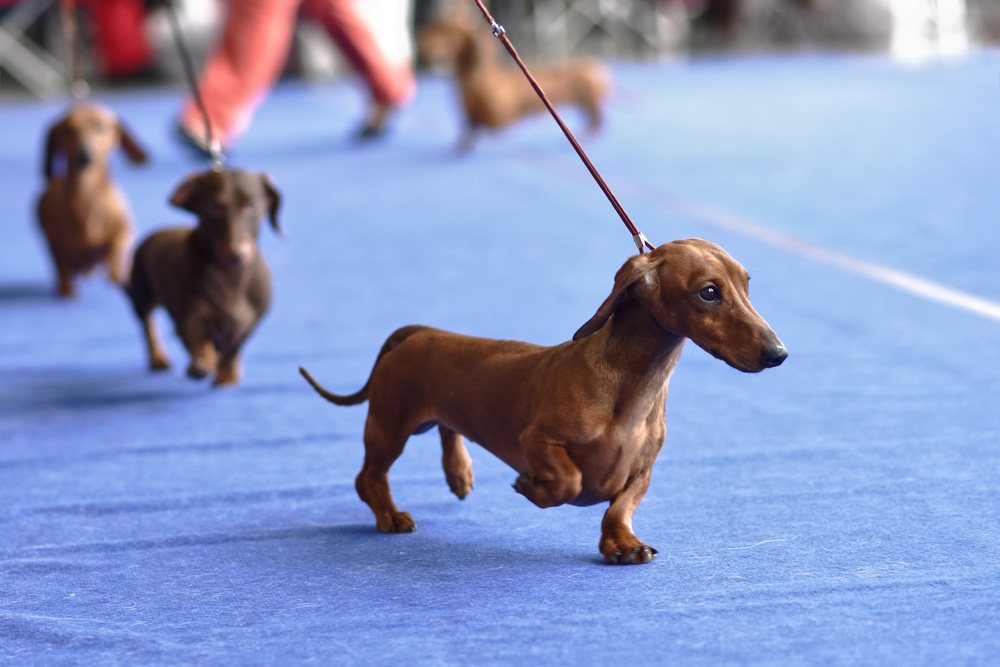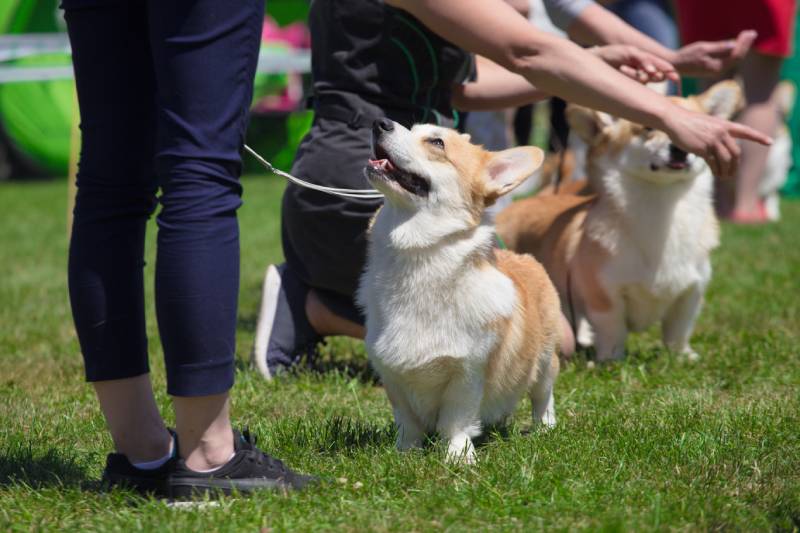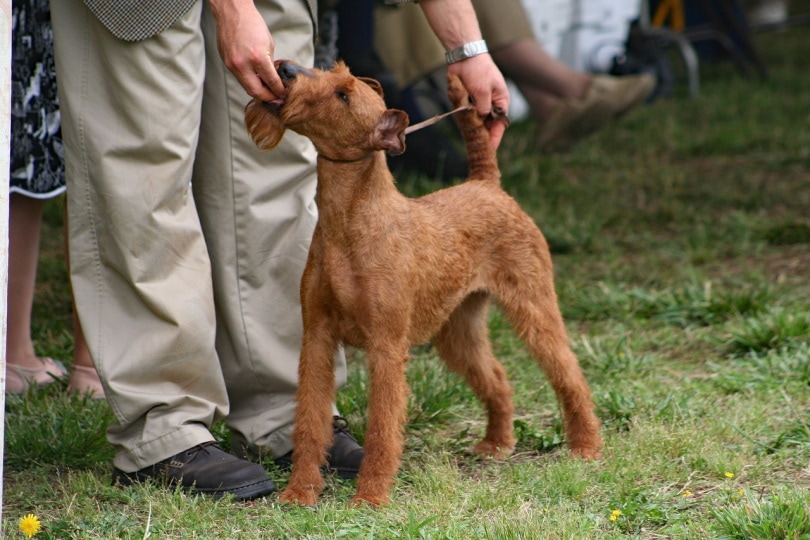Do you have a pup that you feel would excel competing in a dog show but have no idea what that entails or how to get started? If this is you, we’re here to help guide you through the basic process.
We discuss the different types of dog shows, how to train a dog for a show, how to get into one, the classes that you’ll need to take, and other valuable information regarding conformation 1 and dog showing for beginners. Let’s begin!

What Is Conformation, Anyway?
Conformation is the official term for dog shows, which is the act of conforming. Dogs entered into dog shows are measured by how they conform to their breed’s standards. For example, the American Kennel Club (AKC) describes the breed standards for any purebred dog, such as acceptable colors, markings, anatomy, etc. The purpose is to establish a guideline describing a breed’s ideal characteristics, appearance, and temperament and to evaluate breeding stock.
Dogs entered into shows are not compared to the other dogs in the show; they are measured by how well they conform to their own breed’s standards. Why is this necessary? It’s to ensure that future offspring will meet the breed’s standards. This is why you’ll never see mixed or hybrid dogs registered under the AKC, nor will you see them in dog shows.

What Are the Different Types of Dog Shows?
There are three different types of dog shows. They are as follows.
1. All-Breed Shows
All-breed shows are the ones that many people are familiar with and that are shown on television. These provide competition for more than 175 breeds and various dogs recognized by the AKC.


2. Specialty Shows
Specialty shows only allow specific breeds or varieties of specific breeds. For example, the Boston Terrier Club of America is for Boston Terriers only, and the Poodle Club of America allows different varieties of the Poodle: mini, toy, and standard.
3. Group Shows
Group shows only allow dogs that belong to one of the seven groups recognized by the AKC.
- Hound Group: Breeds bred to hunt by sight or scent (Greyhound, Beagle, Basset Hound, Dachshund)
- Herding Group: Breeds bred to herd livestock (Collie, Old English Sheepdog)
- Toy Group: Breeds developed for household companionship (Pug, Chihuahua, Pomeranian, Maltese)
- Non-sporting Group: Diverse group varying in size and function, with many considered champion dogs (Dalmatian, Chow Chow, Bulldog, Poodle)
- Sporting Group: Breeds bred to hunt game birds on land and in water (Pointers, Setters, Retrievers, Spaniels)
- Terrier Group: Breeds bred to hunt vermin, such as rats and mice (Cairn Terrier, Scottish Terrier, Airedale)
- Working Group: Breeds bred for pulling carts, performing search and rescue missions, and guarding property (Doberman Pinscher, Saint Bernard, Boxer, Akita)

What Is Best in Show?
Best in Show is selected from the dogs that have won in their particular group, which is one of the mentioned seven groups designated by the AKC. Best in Show is the highest award that your dog can achieve in a dog show, and dogs can compete for the coveted award by the process of elimination in all-breed shows and limited-breed shows.
While Best in Show is the highest award, other titles are also involved, such as Grand Champion, Select Dog, Select Bitch, and others, along with a new series called the AKC Owner-Handled Series. This is a non-titled competition for dogs shown by handlers who are not professionals. In other words, this new event allows non-professional owners to handle and show their dogs in shows to compete against other non-professional handlers/owners. In this event, one has the opportunity to win at Breed, Group, and Best in Show levels.


How Does a Dog Show Work?
Each dog is handled (or exhibited) by a professional handler to a judge. Most dogs are competing for points toward their AKC championships. To become an American Kennel Club “Champion of Record,” a dog must gain 15 points, which must include two major wins awarded by three different judges. The maximum number of points awarded to a dog in any show is five points. The number of points awarded in a show depends on how many males and females of a particular breed there are in a show; the larger the entry, the greater the number of points each sex can win.
Dog Classes
Each male and female compete separately within their individual breed in seven regular classes:
- Puppy
- 12–15 Months
- Novice
- Amateur-Owner-Handler
- Bred by Exhibitor
- American-Bred
- Open
Essentially, dog shows operate by the process of elimination, with judges selecting a first-place winner in each class.
When it comes to dog shows, think of it as descending a ladder: The more first prizes a dog wins in each class, the closer they get to competing in Best in Show under different titles.
Training a dog for a dog show involves more than just standing still and prancing around the ring. It requires acclimating the dog to being touched all over, including in sensitive areas like the mouth and testicles. Stacking and baiting are essential terms to understand, as they involve getting the dog to hold a pose and respond to treats during judging. Lead training and gaiting are also crucial, as the dog must walk with a proper gait on a lead.
Grooming is another key aspect of preparing for a dog show, especially for dogs with long-haired coats. Keeping the teeth and nails in good condition is essential for a polished appearance in the ring.
To get started in dog shows, the dog must be registered with the AKC, be of the appropriate age and breed, and meet eligibility requirements. Joining a local club specific to the dog’s breed and participating in training classes are recommended steps for newcomers. The AKC New Exhibitor Mentor Program can also provide valuable guidance for those new to dog shows.
While dog shows may seem intimidating at first, they should be enjoyable experiences for both the handler and the dog. Watching experienced handlers can provide valuable insights, and even if a newcomer is eliminated early on, sticking around to observe can lead to learning more tips and tricks for future shows. following sentence: “The dog ran quickly through the park.”
“The dog sprinted through the park with speed.” following sentence:
Please remember to bring your identification card with you when you come to the event.
Don’t forget to bring your identification card when you attend the event.

